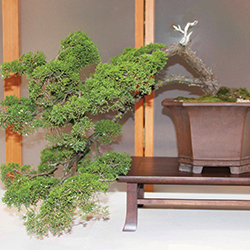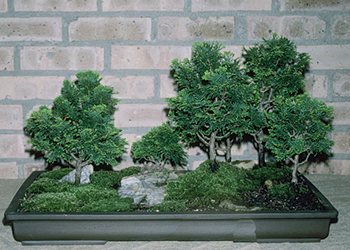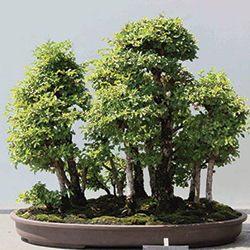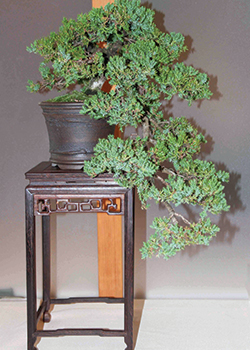There’s more to this marriage of art and horticulture than meets the eye.
A small rock rises toward the overhanging branch, the other side of the shallow dish balanced by the miniature trunk. Finally, I thought, our first bonsai tree—if only we can keep it alive…
I’ll admit it: like many children of the eighties, my first exposure to this ancient art came via The Karate Kid, the coming-of-age film in which a young Jersey boy bonds with a venerable Okinawan karate master. When the student encounters his mentor trimming and shaping his collection of miniature bonsai trees, it seemed a mystical, almost spiritual experience to my younger self, igniting a curiosity that would only begin to be realized some quarter of a century later.
Having started a vegetable garden at home last year, my fiancée and I had grown increasingly interested in keeping plants around the house. But as summer turned to autumn, then winter, more than a few perished—the victims of rudimentary mistakes: too much water or too little, too much sunlight or not enough, and so on.
Never one to admit defeat, we accepted this challenge—and acquired more plants. We learned. And as spring came around again, they “miraculously” stopped dying. As we grew attuned to their needs, the pride that comes with keeping something alive grew as well. Daily chores evolved to accommodate watering needs; road trips became launch pads for visits to botanical gardens. And at some point along the way, we were gifted a bonsai tree.
A World Contained
For many years, I mistook bonsai for a type of plant—a species, or some broader classification. Only recently did I learn it’s a process, a methodology: the art of growing miniature trees in shallow pots. Translated literally from Japanese, the word bonsai means “planted in a container.” I discovered that almost any plant can become a bonsai, though some are better suited than others.
When it comes to bonsai, misconceptions abound: that they are dwarf plants; that they are only grown indoors; that there is a precise formula for the perfect tree. But in fact, bonsai are normal plants kept small through a variety of techniques. Most, depending on the species, grow best outside. And like many art forms, there is no formula; the “rules” of bonsai are subordinate to the creative instinct.
Bonsai trees are intended to look old, regardless of their actual age. The different styles of bonsai reflect the diversity of nature, from the calm, dignified Formal Upright, characterized by a straight, vertical trunk; to Windswept, with trunk and branches growing to one side as if blown by a strong wind; to Cascade, inspired by downward-growing trees clinging to the side of a cliff. There are variations on each style, and still others characterized by multiple trunks, exposed roots, rocky terrain and other earth-inspired elements.
In this unique blend of art and horticulture, the ideal composition reveals the artistic forms inherent in nature. It inspires peace and tranquility—a unity with the natural world. It makes one pause and take notice. It captures the imagination.
Our Dead Juniper
Each time I watered our bonsai, I told myself I’d learn how to properly care for it. Meanwhile, the tree waited patiently for its caretakers. When the needles began to turn brown, I realized we were failing.
Thinking it might be getting too much sun, we moved it to a shadier part of the house. We watered it daily, but nothing seemed to help. While perusing BonsaiEmpire.com—a great resource for beginners—I downloaded its e-book, Bonsai: A Beginner’s Guide, where I read: “The most important rule is: never water on a routine. Ignore the label attached to your bonsai tree which states you need to water every ‘x’ days. Instead, monitor your tree and only water when needed.” But how’s a newbie to know?
“Each species has specific requirements for its cultivation, training and care,” the guide continued—and that’s when I realized: I had no clue what kind of tree we had. Using Bonsai Empire’s online tree ID guide, I thought it resembled the European spruce, but wasn’t confident. It was time to call in an expert.
Finding Peoria’s bonsai club disbanded, I began corresponding with entomologist Phil Nixon, a 35-year veteran of the University of Illinois Extension, and sent him photos to see if he could help me. “This appears to be a juniper in juvenile foliage,” he responded. “Based on its appearance and growth form, it is likely a variety of Juniperus procumbens or Juniperus communis… It is an outdoor plant and hopefully that is where you are keeping it.”
And there was our first mistake. That night, I moved our juniper bonsai to the back deck, but after a few more days, it looked even worse. Then we realized our second mistake: subjecting the poor thing to full sun in August after nearly two months indoors. By the time I moved it (again) into the shade of the front porch, it was dead. In fact, it had probably been gone for weeks.


The Eternal Challenge
“If growing and keeping plants is no longer a challenge, bonsai will provide an eternal challenge.” That’s the line Phil Nixon uses when he gives presentations on the age-old art. He took an interest in bonsai as a college student in the ‘70s—it offered a practical way to keep a variety of plants in a small apartment while he pursued his studies. “I was growing tropical plants, and they were just getting out of hand… People would say, ‘Where’s the machete—so I can find the couch?’” Nixon laughs. “Bonsai is a way to have a number of plants that stay small, but look big.”
Today, he and his wife care for around 100 plants—including 20 to 25 bonsai—in addition to some 700 trees the couple planted over the years on their rural property outside of Champaign-Urbana. “I just really like the look of trees,” he says. “With bonsai, I can have more kinds of trees on a couple benches in my backyard than I can have [fully grown] on my entire 3.5 acres.”
Nixon outlines the “eternal challenge” of bonsai in a nutshell: “You are walking a fine line between life and death, to a certain extent. The plants are essentially dwarfed by restricting the root system… You are pruning the roots and the top growth, then allowing it to grow very slowly to create a miniature representation of what exists in the wild. If you’re attentive to its needs and do the right things at the right time, the tree can be very healthy. On the other hand, things can go downhill very easily.”
Nodding, I sheepishly relate how we’d killed our juniper. “Everyone in bonsai has a myriad of plants they can talk about that died—particularly when you start out,” he says, offering consolation. “A lot of people don’t realize it’s going to take extra care to maintain it; then they aren’t interested in bonsai anymore because the plants ‘just die.’ But they don’t die if you know what you’re doing.”
I always thought bonsai were indoor plants, I said, until he told me otherwise. “In our culture, we associate the idea that if a plant is in a pot, it’s an indoor plant,” he replies. “[Many people] will buy a juniper bonsai in a store and put it on their coffee table—but no one tells you it’s an outdoor plant that needs fresh air. It needs seasonal change and extra light; it needs all those things that it doesn’t get sitting inside.”
Achieving the Design
Look around at the trees and shrubs in your backyard: virtually all of them have the potential to become bonsai. “I have a miniature rose bonsai, styled to look like a tree,” Nixon notes. “I’ve seen bonsai dandelions and even bonsai oak trees.” For the best results, though, one should select plants with a woody trunk, small leaves and a pleasing branch structure. Here in the Midwest, native plants should be grown outdoors, while tropical plants will require some protection from the elements.
In addition to restricting root growth, bonsai plants are styled and kept miniature through a variety of techniques. Rigorous pruning is required to give the tree its initial shape, while routine maintenance-pruning preserves the artistic form. As with other aspects of care, the right amount depends on the type of plant. “Pruning is performed according to the plant’s growth habits,” explains Julie Dantone, a University of Illinois Extension master gardener and horticulture teacher. “Some plants need shaping or pruning only once a year. Others require more attention.”
Wiring, another essential technique, goes hand in hand with pruning. By wrapping copper or aluminum wire around its branches, the plant can be gently positioned into the desired shape. Once the branches have been trained to grow into the shape, the wire is removed. Refinement continues throughout its lifetime—a bonsai is never complete or finished.
Though specialized tools are available, bonsai beginners can get by with the basics: a shallow container, bonsai soil, fertilizer and a pair of pruning shears. “Tools are a personal choosing,” Dantone notes. “You can purchase specific bonsai tools at a premium, or simply use your favorite gardening tools to meet your needs.”
Eventually, most enthusiasts find a concave cutter indispensable for removing larger branches without leaving conspicuous scars, while knob cutters, root cutters, tweezers and twig shears are all worthy additions to one’s bonsai toolbox. “I have also found fishing weights to be a practical tool for shaping and pulling branches to the desired placement,” Dantone adds.
Thick, gnarly trunks and visible surface roots are among the most desirable features of bonsai plants, while elements like textured bark, deadwood, rocks and decorative moss can enhance the miniature landscape. A range of techniques help achieve the desired design, but they’re not all needed—or possible—in any single composition. And that’s one of the most appealing aspects of bonsai: you can always push your explorations further.
Old World in Miniature
“I begin by selecting a plant that has uniform branch shape,” Dantone explains. “A favorite of mine is the Bougainvillea, a tropical plant which produces leaf-like blooms and provides a beautiful, cascading style of bonsai. It is fast-growing and easy to shape. Another favorite is jade (Crassula ovata). You can utilize older jade plants to gain an instant ‘old-world’ appearance.”
“You’ll have better luck if you start out with a tree with smaller leaves,” adds Nixon, “[because] the leaf size tends to be more in proportion with what a large tree with large leaves looks like.” The juniper, he notes, is perfect for beginners because its foliage is similar to a spruce or fir, but its needles are much smaller. This is useful in creating the illusion of bonsai.
“You are trying to make a tree look old that may not be very old at all,” he adds. “A young tree tends to have branches growing upward; an old tree has branches that tend to hang horizontally or downward. So we will take a young pine or spruce and wire the branches so they slant downward, and to the eye, it looks like an older tree. We use the subconscious to fool the eye.”
 Karmic Rewards
Karmic Rewards
On a sunny afternoon in August, my fiancée and I hit the road for Champaign-Urbana, where the Bonsai Society of Central Illinois was offering demonstrations at a festival celebrating Japanese culture. Scattered around Japan House, an elegant facility near the U of I campus, a wide range of bonsai plants were on display, showcasing the beauty and diversity of the art form for a sizeable crowd.
Using a store-bought juniper—the price tag from Lowe’s still dangling from its trunk—Nixon shows the audience how to create a bonsai from scratch. In just 20 minutes, he prunes the rootball down to size, trims and wires a few branches, and fits the tree into a shallow container. Afterward, we chat briefly about our juniper’s demise, and just as we’re about to leave, he hands us the newly created bonsai—as if a reward for our continued interest. We’re grateful for the second chance.
A few weeks later, Julie Dantone welcomes me into the backyard of her Peoria home to discuss what has become a lifelong passion for her. “Bonsai allows a connection with nature and a peaceful mindset for me,” she says. “It has taught me patience, and patience has never been a virtue of mine.”
After showcasing her extensive collection of exotic plants and succulents, she kindly offers a young jade plant to take with me to create a bonsai, a companion for our juniper. “Bonsai can be intimidating,” she agrees, when pressed for advice. “Embrace the simplicity and enjoy bonsai for its face value.”
Armed with this knowledge, I feel we’ve come full-circle. And just as I begin to feel an intuition that wasn’t there before, I realize I’ve been overwatering our new juniper bonsai. But this time around, I figured it out in time. It’s still alive, so far… a&s
Find the Bonsai Society of Central Illinois on Facebook or contact the U of I Extension at (309) 685-3140 for more information. Visit bonsaiempire.com for a plethora of resources for bonsai enthusiasts of all skill levels.


